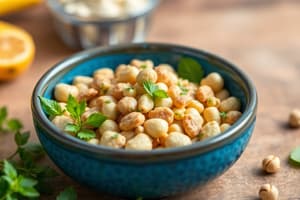Podcast
Questions and Answers
Which of the following best describes the primary function of probiotics?
Which of the following best describes the primary function of probiotics?
- To act as a food source for existing gut bacteria.
- To introduce live microorganisms that provide health benefits. (correct)
- To directly kill harmful bacteria in the gut.
- To prevent further microbial growth in the gut.
Which of these genera are NOT commonly associated with human probiotic microorganisms?
Which of these genera are NOT commonly associated with human probiotic microorganisms?
- Lactobacillus
- Escherichia (correct)
- Bifidobacterium
- Streptococcus
How do probiotics potentially benefit the human host?
How do probiotics potentially benefit the human host?
- By directly stimulating the nervous system.
- By producing essential vitamins for absorption.
- By reducing blood sugar levels.
- By inhibiting the bacterial toxin production. (correct)
What is a primary mechanism by which probiotics compete with pathogens?
What is a primary mechanism by which probiotics compete with pathogens?
In the context of inflammatory bowel diseases, what is the observed effect of probiotics on Ulcerative Colitis, according to the provided information?
In the context of inflammatory bowel diseases, what is the observed effect of probiotics on Ulcerative Colitis, according to the provided information?
What effect have clinical trials found of probiotics on Crohn's disease?
What effect have clinical trials found of probiotics on Crohn's disease?
What was shown about the effects of probiotics on lactose intolerance?
What was shown about the effects of probiotics on lactose intolerance?
What has been observed of probiotics in relation to colorectal carcinoma?
What has been observed of probiotics in relation to colorectal carcinoma?
Which of the following is NOT a demonstrated benefit of probiotic use in cancer patients according to the text?
Which of the following is NOT a demonstrated benefit of probiotic use in cancer patients according to the text?
What effect does Saccharomyces boulardii have on acute, watery diarrhea?
What effect does Saccharomyces boulardii have on acute, watery diarrhea?
In relation to Clostridium difficile disease (CDD), which probiotic has shown effectiveness?
In relation to Clostridium difficile disease (CDD), which probiotic has shown effectiveness?
What is one way in which probiotics reportedly help with viral infections?
What is one way in which probiotics reportedly help with viral infections?
Besides gastrointestinal issues, the text mentions that probiotics can be beneficial for which of the following conditions?
Besides gastrointestinal issues, the text mentions that probiotics can be beneficial for which of the following conditions?
In obese patients, which of the following is NOT listed as a result of probiotic administration?
In obese patients, which of the following is NOT listed as a result of probiotic administration?
What effect do probiotics have on atopic dermatitis (eczema)?
What effect do probiotics have on atopic dermatitis (eczema)?
Which of the following is listed as a condition that probiotics have been shown to have beneficial effects in preventing?
Which of the following is listed as a condition that probiotics have been shown to have beneficial effects in preventing?
What is the primary goal of combining prebiotics and probiotics in synbiotics?
What is the primary goal of combining prebiotics and probiotics in synbiotics?
Besides increased survival, what is another benefit of combining prebiotics with probiotics in synbiotics?
Besides increased survival, what is another benefit of combining prebiotics with probiotics in synbiotics?
Which of the following is a demonstrated effect of prebiotics such as FOS on the immune system?
Which of the following is a demonstrated effect of prebiotics such as FOS on the immune system?
What role do Short-Chain Fatty Acids (SCFAs) play in gene expression?
What role do Short-Chain Fatty Acids (SCFAs) play in gene expression?
Which of the following is NOT a reported property of metabolites that makes them relevant therapeutic candidates?
Which of the following is NOT a reported property of metabolites that makes them relevant therapeutic candidates?
What is one of the therapeutic applications of gut microbiota-associated metabolites?
What is one of the therapeutic applications of gut microbiota-associated metabolites?
Which beneficial effect is associated with synbiotics in patients undergoing post-surgical procedures?
Which beneficial effect is associated with synbiotics in patients undergoing post-surgical procedures?
What is the relationship between SCFAs and inflammation, as discussed in the content?
What is the relationship between SCFAs and inflammation, as discussed in the content?
What is a key characteristic that differentiates prebiotics from dietary fiber?
What is a key characteristic that differentiates prebiotics from dietary fiber?
Which of the following is NOT considered a common prebiotic used in human nutrition?
Which of the following is NOT considered a common prebiotic used in human nutrition?
What is a primary effect of the fermentation of prebiotics in the colon?
What is a primary effect of the fermentation of prebiotics in the colon?
What is one of the proposed mechanisms by which prebiotics influence immunological functions?
What is one of the proposed mechanisms by which prebiotics influence immunological functions?
Which of the following is a key characteristic of compounds classified as prebiotics?
Which of the following is a key characteristic of compounds classified as prebiotics?
What is one of the reported benefits of prebiotics related to lipid levels?
What is one of the reported benefits of prebiotics related to lipid levels?
Which of the following criteria is NOT typically considered when selecting a compound for use as a prebiotic?
Which of the following criteria is NOT typically considered when selecting a compound for use as a prebiotic?
What is the relationship between Bifidobacterium spp. and SCFAs, according to the text?
What is the relationship between Bifidobacterium spp. and SCFAs, according to the text?
Flashcards
Probiotics
Probiotics
Live microorganisms that provide health benefits when consumed in adequate amounts. Often used to restore a balanced gut microbiome.
Prebiotics
Prebiotics
Substances that act as food for beneficial bacteria in the gut, promoting their growth. Examples include inulin and fructans.
Synbiotics
Synbiotics
A combination of probiotics and prebiotics, aiming to provide both beneficial bacteria and their food source.
Fecal Microbiota Transplantation (FMT)
Fecal Microbiota Transplantation (FMT)
Signup and view all the flashcards
Microbiome Modulation
Microbiome Modulation
Signup and view all the flashcards
Gut Microbiome
Gut Microbiome
Signup and view all the flashcards
Healthy Microbiota
Healthy Microbiota
Signup and view all the flashcards
Gut Microbiome Research
Gut Microbiome Research
Signup and view all the flashcards
Cancer Patients and Probiotics
Cancer Patients and Probiotics
Signup and view all the flashcards
Probiotics for Diarrhea
Probiotics for Diarrhea
Signup and view all the flashcards
Probiotics and Diarrhea Types
Probiotics and Diarrhea Types
Signup and view all the flashcards
Probiotics and Viral Infections
Probiotics and Viral Infections
Signup and view all the flashcards
Probiotics for Antibiotic-Associated Diarrhea
Probiotics for Antibiotic-Associated Diarrhea
Signup and view all the flashcards
Probiotics and Extraintestinal Infections
Probiotics and Extraintestinal Infections
Signup and view all the flashcards
Probiotics and Metabolic Health
Probiotics and Metabolic Health
Signup and view all the flashcards
Probiotics and Eczema
Probiotics and Eczema
Signup and view all the flashcards
What are prebiotics?
What are prebiotics?
Signup and view all the flashcards
How are prebiotics digested?
How are prebiotics digested?
Signup and view all the flashcards
Name some examples of prebiotics.
Name some examples of prebiotics.
Signup and view all the flashcards
What effect do prebiotics have on gut bacteria?
What effect do prebiotics have on gut bacteria?
Signup and view all the flashcards
What are the possible health benefits of prebiotics?
What are the possible health benefits of prebiotics?
Signup and view all the flashcards
Give specific examples of prebiotic benefits.
Give specific examples of prebiotic benefits.
Signup and view all the flashcards
How do prebiotics influence liver health?
How do prebiotics influence liver health?
Signup and view all the flashcards
What is unknown about prebiotics?
What is unknown about prebiotics?
Signup and view all the flashcards
FOS (Fructooligosaccharides)
FOS (Fructooligosaccharides)
Signup and view all the flashcards
SCFAs (Short-Chain Fatty Acids)
SCFAs (Short-Chain Fatty Acids)
Signup and view all the flashcards
Probiotics and Liver Health
Probiotics and Liver Health
Signup and view all the flashcards
Synbiotics and Modulation of Gut Microbiota
Synbiotics and Modulation of Gut Microbiota
Signup and view all the flashcards
Gut Microbiota Metabolites
Gut Microbiota Metabolites
Signup and view all the flashcards
GALTs (Gut-Associated Lymphoid Tissues)
GALTs (Gut-Associated Lymphoid Tissues)
Signup and view all the flashcards
IgA (Immunoglobulin A)
IgA (Immunoglobulin A)
Signup and view all the flashcards
Study Notes
Prebiotics, Probiotics, and Gut Microbiome Modulation
- Prebiotics are non-digestible food components that selectively nourish beneficial gut microorganisms.
- Probiotics are live microorganisms that confer health benefits when administered in adequate amounts.
- Modulation of the gut microbiota can be achieved by dietary approaches or therapeutic interventions.
- Not all dietary interventions or probiotics are universally beneficial.
Therapeutic Strategies
- Prebiotics
- Probiotics
- Synbiotics (combination of prebiotics and probiotics)
- FMT (fecal microbiota transplantation)
- Phage therapy
- miRNA modulation
Probiotic Criteria
- Safety: Human or animal origin, history of safe use, absence of disease association, no adverse effects, no antibiotic resistance genes.
- Functionality: Competitiveness in the gut, ability to survive and metabolise in the gut, resistance to bile salts and enzymes and low pH, antagonistic activity against pathogens.
- Technological Usability: Easy and stable production, high viability and stability during processing and storage.
Probiotic Microorganisms
- Lactobacillus, Bifidobacterium, Lactococcus, Streptococcus, Enterococcus, Bacillus, Saccharomyces, and others.
Mechanisms of Probiotic Beneficial Effects
- Antagonism (production of antimicrobial substances)
- Competition with pathogens
- Immunomodulation
- Positive effects on metabolism
- Inhibition of bacterial toxin production
Probiotics and Inflammatory Bowel Diseases
- Ulcerative colitis: Probiotics can lead to remission.
- Crohn's disease: No positive effect shown.
- Lactose intolerance: Increased lactose digestion and tolerance, reduced diarrhoea.
- Irritable bowel syndrome: Improvements in symptoms (bloating, pain, constipation, cramps, flatulence, potentially).
Probiotics and Cancer
- Animal studies suggest a potential risk reduction, but clinical trials have not confirmed it.
- Probiotics may alleviate gastrointestinal disorders in cancer patients.
- Possible improvements in gut mucosal barrier integrity, reduction in diarrhoea incidence, and less abdominal discomfort.
Probiotics and Diarrhoea & Intestinal Infections
- Saccharomyces boulardii yeast can reduce acute watery diarrhoea frequency.
- Probiotics can be used in nosocomial, non-nosocomial, and viral diarrhoea treatment and may boost IgA antibody production.
- Antibiotics-related diarrhoea (AAD) and Clostridium difficile disease (CDD) show strong responses to probiotics (especially Saccharomyces boulardii).
Probiotics and Extraintestinal Infections
- Probiotics may prevent vaginitis and reduce respiratory tract infections.
- Children with cystic fibrosis may experience reduced pulmonary exacerbations with probiotic administration.
- Probiotics might reduce nosocomial infections (e.g., VAP).
Probiotics and Metabolic Disorders
- Probiotic administration can reduce BMI, arterial BP, and improve lipid profiles and insulin sensitivity in obese individuals.
- Significant reduction in blood glucose, HbA1C, LDL, and total cholesterol in patients with type 2 diabetes.
Probiotics and Atopic Dermatitis (Eczema)
- Probiotic administration to pregnant women and their infants can reduce infant eczema.
- Probiotic treatment can improve AD severity in children with improved IFN-γ and IL-10 ratios.
In Recent Randomized Controlled Trials
- Probiotics may prevent diarrhoea, necrotising enterocolitis, ulcerative colitis, and respiratory tract issues.
- Probiotic treatment could improve cardiometabolic parameters and reduce CRP levels in type 2 diabetes patients.
Prebiotics
- Prebiotics are selectively used to nourish beneficial gut microbial organisms.
- Resistance to digestion in the upper GIT
- Fermentation by gut microbiota
- Beneficial effects on host's health
- Selective stimulation of probiotics growth
- Stability in various food processing conditions
Sources of Prebiotics
- Fruit, vegetables, cereals, and other edible plants.
- Carbohydrates like dietary fibre.
- Prebiotic examples: FOS, GOS, inulin, XOS, lactitol, lactosucrose, lactulose, soy oligosaccharides, and transgalactooligosaccharides.
Fermentable Dietary Fibres
- Inulin, oligofructose, FOS, galactooligosaccharides.
- Increase Bifidobacterium and Lactobacillus in stool samples (and linked to increased SCFAs).
Health Benefits from Prebiotics
- Prevention of carcinogenesis.
- Reduction of blood LDL levels.
- Stimulation of the immunological system.
- Absorbability enhancement of calcium.
- Intestinal pH value maintenance.
Mechanisms of Prebiotic Effects
- Regulation of hepatic enzymes by influencing SCFAs production (e.g., butyric acid).
- Histone acetylation modulation through SCFAs production.
- Modulation of mucin production.
- Increased lymphocyte and/or leukocyte count in association lymphoid tissues.
- IgA secretion enhancement.
Synbiotics
- Combination of prebiotics and probiotics.
- Improvement of probiotic survival in the GI tract.
- Stimulation of native gut bacteria proliferation.
- Increased tolerance of probiotics to environmental factors (oxygenation, pH, temperature).
- Examples: Lactobacillus + inulin, Lactobacillus + FOS, Lactobacillus + oligofructose, Lactobacillus + inulin.
Beneficial Effects of Synbiotics
- Increased counts of Lactobacillus and Bifidobacterium in the gut.
- Improved hepatic function in cirrhosis patients.
- Enhanced immunomodulation.
- Reduced incidence of nosocomial infections (e.g., post-surgical settings).
Clinical Trial Examples
- Synbiotic interventions affect weight, blood glucose, lipid profiles, and insulin resistance.
- Synbiotics may help with IBS, eczema, IBD, and lactose intolerance.
- Specific synbiotics are associated with positive results in certain diseases and conditions.
Metabolites
- Gut microbiota-associated metabolites are crucial in disease development and progression
- Metabolites are used in treating inflammation, metabolic and neurological disorders/diseases, and cancer.
- Advantages: natural bioavailability, high concentrations, easy administration, and tolerable tissue effects
Short-Chain Fatty Acids (SCFAs)
- Exhibit anti-inflammatory effects
- Oral administration alleviates brain inflammation and symptoms associated with multiple sclerosis.
- Colon delivery of SCFAs may counteract psychosocial stress effects.
Other Novel Approaches
- miRNAs: Crucial for homeostasis and have a role in post-transcriptional gene expression regulation.
- Hyaluronan: Unbranched glycosaminoglycan component of the extracellular matrix involved in IBD promotion/resolution.
- Nanomaterials: Possible tools for impacting disease-causing microorganisms and their metabolites in the microenvironment of the cancer.
Studying That Suits You
Use AI to generate personalized quizzes and flashcards to suit your learning preferences.




